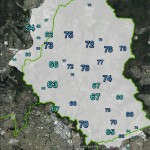The final list of candidates was released on Friday. A record number of candidates are running in both houses of Parliament – in line with the record number of parties registering at the election.
A total of 1188 candidates are running for the House of Representatives, and 529 are running in the Senate.
Three parties nominated candidates in all 150 seats: the ALP, the Greens and the Palmer United Party. The four Coalition parties collectively nominated 160 candidates, which amounts to ten seats where the Liberal and National parties are competing.
The next biggest party is Family First, who are running 93 candidates. Rise Up Australia are running 77, and Katter’s Australian Party are running 63. The Christian Democratic Party are running in all 48 NSW seats, and their allies the Australian Christians are running in 31 more, bringing them to a total of 79.
Other parties running more than thirty are the Sex Party (36) and the Democratic Labour Party (33).
Antony Green has blogged about the changes in number of candidates since 2010.
I have also updated my spreadsheet, reflecting the list provided by the AEC as well as gender data that I have gathered. Please let me know if you see any errors. You can download the spreadsheet here.
The other news over the weekend was the release of the Group Voting Tickets in the Senate. These releases are always dominated by what parties have made decisions that clash with their political agenda, due to political wheeling and dealing.
Over Sunday the biggest story was the decisions of Wikileaks to put conservative parties ahead of the Greens in the Senate. Wikileaks have claimed an administrative error was responsible for putting the Greens behind Australia First and the Shooters and Fishers in NSW, but have defended a decision putting Greens Senator Scott Ludlam, an outspoken supporter of Wikileaks in the Senate, behind his main rival from the Nationals in Western Australia.
There are a whole bunch of other examples of these sorts of decisions by many parties. The most interesting other result was the failure of a series of right-wing parties to lodge a group voting ticket in Victoria, which will result in those candidates only being able to receive below-the-line votes.
Poll Bludger has gone further in outlining how parties are directing their preferences.







